Black And Decker BT4000 Handleiding
Black And Decker
Zaagmachine
BT4000
Bekijk gratis de handleiding van Black And Decker BT4000 (5 pagina’s), behorend tot de categorie Zaagmachine. Deze gids werd als nuttig beoordeeld door 46 mensen en kreeg gemiddeld 4.9 sterren uit 23.5 reviews. Heb je een vraag over Black And Decker BT4000 of wil je andere gebruikers van dit product iets vragen? Stel een vraag
Pagina 1/5

WARNING: For your own safety read instruction manual before operating tool.
Grounding Instructions
In the event of a malfunction or breakdown, grounding provides a path of least resistance for
electric current to reduce the risk of electric shock. This tool is equipped with an electric cord
having an equipment-grounding conductor and grounding plug. The plug must be plugged
into a matching outlet that is properly installed and grounded in accordance with all local
codes and ordinances. Do not modify plug provided—if it will not fit the outlet, have the proper
outlet installed by a qualified electrician.
Improper connection of the equipment-grounding conductor can result in a risk of electric
shock. The conductor with insulation having an outer surface that is green with or without
yellow stripes is the equipment-grounding conductor. If repair or replacement of the electric
cord or plug is necessary, do not connect the equipment-grounding conductor to a live
terminal.
Check with a qualified electrician or service personnel if the grounding instructions are not
completely understood, or if in doubt as to whether the tool is properly grounded.
Use only 3-wire extension cords that have 3-prong grounding plugs and 3-pole receptacles
that accept the tool’s plug.
Repair or replace damaged or worn cords immediately.
This tool is intended for use on a circuit that has an outlet that looks like the one illustrated in
Figure A. The tool has a grounding plug that looks like the plug illustrated in Figure A. A
temporary adapter, which looks the adapter illustrated in Figures B and C, may be used to
connect this plug to a 2-pole receptacle as shown in Figure B if a properly grounded outlet is
not available. The temporary adapter should be used only until a properly grounded outlet
can be installed by a qualified electrician. The green-colored rigid ear, lug, and the like,
extending from the adapter must be connected to a permanent ground such as a properly
grounded outlet box.
WARNING: Read and understand all instructions. Failure to follow all instructions listed
below may result in electric shock, fire and/or serious personal injury.
Important Safety Instructions
•KEEP GUARDS IN PLACE and in working order.
•REMOVE ADJUSTING KEYS AND WRENCHES. Form habit of checking to see that keys
and adjusting wrenches are removed from tool before turning it on.
•KEEP WORK AREA CLEAN. Cluttered areas and benches invite injuries.
•DON’T USE IN DANGEROUS ENVIRONMENT. Don’t use power tools in damp or wet
locations, or expose them to rain. Keep work area well lighted.
•KEEP CHILDREN AWAY. All visitors should be kept safe distance from work area.
•MAKE WORKSHOP KID PROOF with padlocks, master switches, or by removing starter
keys.
•DON’T FORCE TOOL. It will do the job better and safer at the rate for which it was
designed.
•USE RIGHT TOOL. Don’t force tool or attachment to do a job for which it was not designed.
•USE PROPER EXTENSION CORD. Make sure your extension cord is in good condition.
When using and extension cord, be sure to use one heavy enough to carry the current your
product will draw. An undersized cord will cause a drop in line voltage resulting in loss of
power and overheating. The following table shows the correct size to use depending on
cord length and nameplate ampere rating. If in doubt, use the next heavier gage. The
smaller the gage number, the heavier the cord.
•OUTDOOR USE EXTENSION CORDS. When tool is used outdoors, use only extension
cords intended for use outdoors and so marked.
•WEAR PROPER APPAREL. Do not wear loose clothing, gloves, neckties, rings, bracelets,
or other jewelry which may get caught in moving parts. Nonslip footwear is recommended.
Wear protective hair covering to contain long hair.
•ALWAYS USE SAFETY GLASSES. Also use face or dust mask if cutting operation is dusty.
Everyday eyeglasses only have impact resistant lenses, they are NOT safety glasses.
•DON’T OVERREACH. Keep proper footing and balance at all times.
•MAINTAIN TOOLS WITH CARE. Keep tools sharp and clean for best and safest per-
formance. Follow instructions for changing accessories.
•DISCONNECT TOOLS before servicing; when changing accessories, such as blades, bits,
cutters, and the like.
•REDUCE THE RISK OF UNINTENTIONAL STARTING. Make sure switch is in off position
before plugging in.
•USE RECOMMENDED ACCESSORIES. Consult the instruction manual for recommended
accessories. The use of improper accessories may cause risk of injury to persons.
•NEVER STAND ON TOOL. Serious injury could occur if the tool is tipped or if the cutting tool
is unintentionally contacted.
•CHECK DAMAGED PARTS. Before further use of the tool, a guard or other part that is
damaged should be carefully checked to determine that it will operate properly and perform
its intended function–check for alignment of moving parts, binding of moving parts, breakage
of parts, mounting, and any other conditions that may affect its operation. A guard or other
part that is damaged should be properly repaired or replaced.
•NEVER LEAVE TOOL RUNNING UNATTENDED. TURN POWER OFF. Don’t leave tool
until it comes to a complete stop.
ADDITIONAL SAFETY RULES FOR SCROLL SAWS
•MATERIAL HOLD-DOWN must be properly set according to these instructions and remain
in position during use.
•NEVER reach under the table when operating or make any adjustments when it is running.
•SECURE saw to work bench or stand with clamps or mounting hardware. Secure work
bench or stand to floor.
•DO NOT use the upper arm as a lifting point.
•MAKE SURE blade tension is properly adjusted.
•AVOID awkward hand positions where a sudden slip could cause a hand to move into a saw
blade or cutting tool. DO NOT PLACE FINGERS OR HANDS IN PATH OF THE SAW
BLADE.
•WHEN REMOVING short workpieces, or cleaning up around the table, be sure the saw is in
the OFF position and blade has stopped moving.
•NEVER turn the saw ON before clearing the table of all tools, wood scraps, etc., except the
workpiece and related feed or support devices for the operation planned.
•CHECK for proper blade size and type.
•DO NOT attempt to saw stock that does not have a flat surface, unless a suitable support is
used.
•HOLD material firmly against table and feed into blade teeth at a moderate speed.
•TURN OFF motor if the material resists being backed out of an uncompleted cut. Use
appropriate speed for applications.
•MAKE “relief” cuts before cutting long curves.
•USE a dust mask and safety glasses when sawing.
•KEEP GUARDS in place and working order.
•MAKE SURE your fingers do not contact the terminals of the power cord when installing or
removing the plug to or from the line power source.
•NEVER overfeed or force work into the blade.
•WARNING: Do not allow familiarity (gained from frequent use of your saw) to replace
following safety rules. Always remember that a careless fraction of a second is sufficient to
inflict severe injury.
WARNING: Some dust created by power sanding, sawing, grinding, drilling, and other
construction activities contains chemicals known to cause cancer, birth defects or other repro-
ductive harm. Some examples of these chemicals are:
• lead from lead-based paints,
• crystalline silica from bricks and cement and other masonry products, and
• arsenic and chromium from chemically-treated lumber. (CCA)
Your risk from these exposures varies, depending on how often you do this type of work. To
reduce your exposure to these chemicals: work in a well ventilated area, and work with
approved safety equipment, such as those dust masks that are specially designed to filter out
microscopic particles.
KEY INFORMATION YOU SHOULD KNOW:
•For best performance, secure saw to work bench or stand with clamps or mounting
hardware. Secure work bench or stand to floor.
VEA EL ESPAÑOL EN LA CONTRAPORTADA.
SAVE THIS MANUAL FOR FUTURE REFERENCE.
INSTRUCTIVO DE OPERACIÓN, CENTROS DE SERVICIO Y
PÓLIZA DE GARANTÍA. ADVERTENCIA: LÉASE ESTE
INSTRUCTIVO ANTES DE USAR EL PRODUCTO.
INSTRUCTION MANUAL
Catalog Number BT4000
1-800-54-HOW-TO
1-800-54-HOW-TO
1-800-54-HOW-TO
1-800-54-HOW-TO1-800-54-HOW-TO
BEFORE RETURNING THIS PRODUCT
BEFORE RETURNING THIS PRODUCT
BEFORE RETURNING THIS PRODUCT
BEFORE RETURNING THIS PRODUCT BEFORE RETURNING THIS PRODUCT
FOR ANY REASON PLEASE CALL
FOR ANY REASON PLEASE CALL
FOR ANY REASON PLEASE CALL
FOR ANY REASON PLEASE CALLFOR ANY REASON PLEASE CALL
IF YOU SHOULD EXPERIENCE A PROBLEM
WITH YOUR PURCHASE,BLACK & DECKER
CALL .1-800-54-HOW-TO (1-800-544-6986)
IN MOST CASES, A BLACK & DECKER REPRESENTATIVE
CAN RESOLVE YOUR PROBLEM OVER THE PHONE.
IF YOU HAVE A SUGGESTION OR COMMENT,
GIVE US A CALL. YOUR FEEDBACK IS VITAL
TO THE SUCCESS OF BLACK & DECKER'S QUALITY
IMPROVEMENT PROGRAM.
(544-6986)
Catalog No. BT4000 Form No. 398178-00 (JUL00-1) Copyright © 2000 Black & Decker Printed in Taiwan
R
1
1
1
1
1
1
1
1
1
16
6
6
6
6
6
6
6
6
6”
”
”
”
”
”
”
”
”
”
V
V
V
V
V
V
V
V
V
VA
A
A
A
A
A
A
A
A
AR
R
R
R
R
R
R
R
R
RI
I
I
I
I
I
I
I
I
IA
A
A
A
A
A
A
A
A
AB
B
B
B
B
B
B
B
B
BL
L
L
L
L
L
L
L
L
LE
E
E
E
E
E
E
E
E
ES
S
S
S
S
S
S
S
S
SP
P
P
P
P
P
P
P
P
PE
E
E
E
E
E
E
E
E
EE
E
E
E
E
E
E
E
E
ED
D
D
D
D
D
D
D
D
DS
S
S
S
S
S
S
S
S
SC
C
C
C
C
C
C
C
C
CR
R
R
R
R
R
R
R
R
RO
O
O
O
O
O
O
O
O
OL
L
L
L
L
L
L
L
L
LL
L
L
L
L
L
L
L
L
LS
S
S
S
S
S
S
S
S
SA
A
A
A
A
A
A
A
A
AW
W
W
W
W
W
W
W
W
W
1
3
45
Mounting Hole
Orifice de montage
Perforación para montaje
2
Bottom Thumbscrew
Vis oreillesà
inf rieureé
Tornillo de mariposa
inferior
Top Thumbscrew
Vis oreilles sup rieureà é
Tornillo de mariposa superior
Blade Tension Lever
Levier de r glage deé
tension de la lame
Palanca de tensi n deó
la sierra
Table Insert
Plaquette amovible du
plateau
Mesa amovible
Material Hold Down / Guard
Dispositif de fixation du mat riaué
Sujetador del material
Thumbscrews
Vis oreillesà
Tornillos de
mariposa
Pad Lock Slot
Orifice pour
cadenas
Ranura de bloqueo
de la placa
Blade Storage Tray
Bac de rangement des lames
Bandeja de almacenamiento de sierras
Switch
Interrupteur
Interruptor
A B C
GROUNDING PIN
GROUNDED
OUTLET
BOX GROUNDING
MEANS
Minimum Gage for Cord Sets
Volts Total Length of Cord in Feet
120V 0-25 26-50 51-100 101-150
240V 0-50 51-100 101-200 201-300
Ampere Rating
More Not more American Wire Gage
Than Than
0 - 6 18 16 16 14
6 - 10 18 16 14 12
10 - 12 16 16 14 12
12 - 16 14 12 Not Recommended
ADAPTER-(NOT APPLICABLE IN CANADA)

The label on your tool may include the following symbols.
V ..........................volts A..........................amperes
Hz ........................hertz W ........................watts
min ........................minutes ......................alternating current
......................direct current no ........................no load speed
..........................Class II Construction ........................earthing terminal
........................safety alert symbol .../min ..................revolutions or
reciprocations
per minute
Motor
Be sure the power supply agrees with nameplate marking. 120 Volts AC only means your tool
will operate on standard 60 Hz household power. Do not operate AC tools on DC. A rating of
120 volts AC/DC means that your tool will operate on standard 60 Hz AC or DC power. This
information is printed on the nameplate. Lower voltage will cause loss of power and can result
in over-heating. All Black & Decker tools are factory-tested; if this tool does not operate, check
the power supply.
Unpacking Your Saw
Check the contents of your scroll saw carton to make sure that you have received all parts. In
addition to this instruction manual, the carton should contain one No. BT4000 scroll saw and
the following:
- (12) assorted blades (1 already installed on unit)
- (1) zero clearance table insert
- (1) pattern book / helpful hints
- (3) rubber mounting feet
Mounting
Three holes are provided in the base of the scroll saw to facilitate mounting to a table or
bench (Figure 1). Place three rubber mounting feet from hardware bag into the three mount-
ing holes. Always mount your saw firmly to prevent movement. Do not over tighten mounting
bolts. Leave some cushion in the rubber feet for absorbing noise and vibration.
Aligning the Blade With the table Top
This is most easily accomplished with a carpenter s tri-square. Begin by installing a blade in’
the saw. Next, place the tri-square on the table top, close to the blade. Observe the align-
ment of the blade to the edge of the square. The blade should be vertically parallel to the tri-
square edge. If it is not, you need to adjust the zero degree stop as described in the follow-
ing paragraph.
Adjusting the Zero Degree Stop
The zero degree stop is located on top of the motor housing on the right side of the saw
below the table (Figure 6). The stop is preset at the factory to have the table rest at 0˚. To
adjust the zero degree stop, tilt the table to 45 . Loosen the nut, located at the bottom of the˚
bolt. The bolt can then be turned to correctly align the table at 0˚. Tilt the table to the right
until it stops on the bolt. Re-check the alignment of the blade with the table top. If the align-
ment is correct, tighten the nut finger tight.
To allow the table to tilt 1 or 2 to the right, turn the zero degree stop completely clockwise.˚ ˚
Installing the Blade
BEFORE INSTALLING A BLADE, UNPLUG THE SCROLL SAW.
The blade is held in place by the thumbscrew blade clamps attached to the top and bottom
arms of the scroll saw (Figure 2).
Before installing a blade, make sure the blade tension lever is rotated upward as shown in
Figure 3. Remove the table insert and loosen, but do not unscrew, the top and bottom thumb-
screws (Figure 2). Thread the blade through the hole in table, with the teeth facing toward
the front of the saw. Scroll saws cut on the downstroke, so it is essential that teethNOTE:
face forward and down.
Insert the blade into the bottom blade clamp and securely tighten the thumbscrew. Reinstall
table insert. Next, insert the top of the blade into the top blade clamp and securely tighten
the top thumbscrew.
Properly adjust the tension of the blade before operating your scroll saw. (See: Blade Tension
Lever section of this manual.)
Blade Tension Lever
Move the blade tension lever (Figure 3) downward to tension the blade.
NOTE: The lever should move downward with a steady even pressure. The blade is too tight
if excessive pressure is needed.
TO FINE ADJUST THE TENSION ON THE BLADE FOLLOW THE STEPS
BELOW.
1.) To decrease tension, rotate the tension lever counterclockwise 1 or 2 turns.
2.) If the blade is too loose the tension can be increased by leaving the lever in the down
position and turning it clockwise until you feel the tension increase on the blade.
The proper degree of tension varies with different blade sizes. If you are frequently breaking
blades, decrease tension on the blade.
As you become more accustomed to operating your scroll saw, you will become more proficient
in fine-tuning blade tension. Practice on scrap material when possible.
Remove the blade or release tension on the blade when not using your scroll saw for an
extended period. Blade tension can be removed by flipping the blade tension lever up. Be sure
to place the blade tension lever in its downward position again before turning saw on.
Material Hold-down / Guard
The material hold-down (Figure 4) should contact the surface of the workpiece. To adjust the
material hold-down / guard, loosen the thumbscrew (Figure 4) and move the rod up or down.
The material hold-down / guard must be beveled when the table is beveled. To bevel the
material hold-down / guard, loosen the thumbscrew shown in Figure 4 and bevel the mater-
ial hold-down / guard until it is parallel to the table. Retighten the material hold-down / guard
before cutting.
Your scroll saw has a maximum thickness capacity of 2" at 0 . Do not cut material thicker˚
than 2". NEVER remove the material hold-down since it also functions as aCAUTION:
barrier between fingers and blade. This is especially important when cutting metals; sharp
edges may be present
Air Hose
Your scroll saw features an adjustable air hose to keep your work area free from dust and
debris. Be sure to position the air hose properly: it should blow saw dust away from the oper-
ator.
On/Off Switch
To turn the scroll saw on, pull up on the switch shown in Figure 5. To turn the tool off, push
down on the switch. A slot is provided for insertion of a padlock to lock the saw off (Figure 5).
NOTE: The pad lock shackle diameter should be between 3/16 and 7/32” ”.
GUIDE D’UTILISATION
Speed Control Knob
Your scroll saw features a variable speed control, from 400 to 1,700 strokes per minute. To
operate the variable speed feature, turn the speed control knob (Figure 5).
To increase the speed, turn the knob clockwise. The numbers on the speed control knob
represent speed ranges. is the minimum speed, is the maximum speed.1 5
Slower speeds are recommended for metals, plastics, harder woods and very thin materials.
Sawing
Hold material firmly against table. Always feed material toward the blade. Feed the workpiece
fast enough to allow the blade to cut, but do not force material into the blade too quickly.
CAUTION: The scroll saw should be used to cut wood, wood-like products, plastics
and nonferrous metals (aluminum, copper, brass etc.) only. DO NOT use for cutting ferrous
metals such as iron and steel. Note that when cutting nonferrous metals, the hot metal
shavings can cause a fire when coming in contact with sawdust.
When sawing nonferrous metals:
• Vacuum all sawdust from inside and under the saw before use.
• Vacuum all traces of metal dust (after it has completely cooled) from inside and under the
saw before using saw to cut wood, etc.
Sawdust Collection Port
A sawdust collection port is located on the side of the saw as shown in Figure 6. To use the
port, attach a 1-1/4 vac hose to the opening.”
NOTE: Through normal use sawdust accumulates under the saw. Frequently clean sawdust
from under the unit to prevent the linkage from binding, which could overload and damage the
motor. A hole can also be cut in the bench or stand below the lower blade clamp in such a man-
ner that will not allow sawdust to accumulate under the tool.
Beveling
The table of your scroll saw bevels 47 left and -2 right. A stop is set at 0 . To bevel the scroll° ° °
saw table, loosen the bevel lock knob (Figure 7), and bevel the table to the desired setting,
indicated by the bevel pointer.
Fretwork
INSIDE CUTS
Your scroll saw is ideal for making inside cuts for detail work. To make an inside cut:
1. Drill a pilot hole in your workpiece.
2. Make sure the blade tension lever is rotated upward to remove tension.
3. Loosen the top blade clamp knob.
4. Leaving the blade held in place by the bottom blade clamp, thread the saw blade through
the pilot hole in your workpiece and reattach the blade by tightening the top blade clamp
knob.
5. Readjust the blade tension and begin the inside cut.
Zero Clearance Table Insert
A Zero Clearance Table Insert (solid orange plastic circular disk) is included with the scroll
saw. It is designed to give maximum support to the underside of the workpiece and to prevent
small workpieces from falling into the saw.
When working with small workpieces with the table set at 0 , remove the standard insert and˚
replace with the Zero Clearance Table Insert.
Before using, drill a hole in the center of the disk for the blade. You should drill the smallest
hole possible that will allow the blade to move freely.
Table
Keep the table clean and free from oil, grease and pitch. Treat the table with paste wax to
help maintain its smooth finish.
Blade Storage Tray
A convenient storage tray for blades is built into the top of the saw (Figure 5).
Accessories
Use only 5" plain end and pin scroll saw blades. Recommended accessories for use with your
tool are available at extra cost from your local dealer or authorized service center. If you
need assistance in locating any accessory for your tool, please call:
1-800-54-HOW-TO (544-6986).
CAUTION: The use of any other accessory not recommended for use with this tool
could be hazardous.
Maintenance
Use only mild soap and damp cloth to clean the tool. Never let any liquid get inside the tool;
never immerse any part of the tool into a liquid. Dry table thoroughly to prevent rust.
IMPORTANT: To assure product SAFETY and RELIABILITY, repairs, maintenance and
adjustment should be performed by authorized service centers or other qualified service per-
sonnel, always using identical replacement parts.
Service Information
Black & Decker offers a full network of company-owned and authorized service locations
throughout North America. All Black & Decker Service Centers are staffed with trained person-
nel to provide customers with efficient and reliable power tool service.
Whether you need technical advice, repair, or genuine factory replacement parts, contact the
Black & Decker location nearest you. To find your local service location, refer to the yellow
pages directory under "Tools Electric" or call: —1-800-54-HOW-TO (544-6986).
Full Two-Year Home Use Warranty
Black & Decker (U.S.) Inc. warrants this product for two years against any defects in material
or workmanship. The defective product will be replaced or repaired at no charge in either of two
ways.
The first, which will result in exchanges only, is to return the product to the retailer from whom
it was purchased (provided that the store is a participating retailer). Returns should be made
within the time period of the retailer’s policy for exchanges (usually 30 to 90 days after the sale).
Proof of purchase may be required. Please check with the retailer for their specific return poli-
cy regarding returns that are beyond the time set for exchanges.
The second option is to take or send the product (prepaid) to a Black & Decker owned or autho-
rized Service Center for repair or replacement at our option. Proof of purchase may be required.
Black & Decker owned and authorized Service Centers are listed under "Tools-Electric" in the
yellow pages of the phone directory.
This warranty does not apply to accessories. This warranty gives you specific legal rights and
you may have other rights which vary from state to state. Should you have any questions, con-
tact the manager of your nearest Black & Decker Service Center. This product is not intended
for commercial use.
See ‘Tools-Electric’
– Yellow Pages –
for Service & Sales
Black & Decker (U.S.) Inc.,
701 E. Joppa Rd.
Towson, MD 21286 U.S.A.
6
7
Zero Degree Stop
But e de z ro degré é é
Posici n a cero gradosó
Dust Collection Port
Orifice d vacuation’é
Salida para
recolecci n del aserró ín
Bevel Lock Knob
Bouton de
verrouillage
d’angle de biseau
Perilla de
bloqueo para
biselado
Mise à la terre
En cas de mauvais fonctionnement ou de bris de l outil, la mise la terre procure un chemin’ à
de moindre r sistance au courant lectrique afin de minimiser les risques de secousses é é élec-
triques. Le cordon de l outil comporte un conducteur de terre et une fiche de mise la terre.’ à
La fiche doit tre branch e dans une prise de machine bien install e et mise la terre con-ê é é à
formément aux lois et règlements locaux. Ne pas modifier la fiche fournie. Lorsque la fiche
n’entre pas dans la prise, demander à un électricien qualifié d’installer une prise appropriée.
La mauvaise connexion du conducteur de terre de l outil pr sente des risques de secousses’ é
é ’lectriques. Le conducteur dont l isolant est vert ou vert avec des lignes jaunes constitue la
mise à la terre. En cas de réparation ou de remplacement du cordon ou de la fiche, ne pas
relier le conducteur de terre une borne sous tension.à
Consulter un lectricien qualifi ou le personnel des centres de service an cas dé é ’incom-
préhension des instructions relatives à la mise à la terre ou en cas de doute quant à la mise
à ’ la terre de l outil.

AVERTISSEMENT : Certains outils, tels que les sableuses électriques, les scies, les meules,
les perceuses ou certains autres outils de construction, peuvent soulever de la poussi re con-è
tenant des produits chimiques susceptibles d’entraîner le cancer, des malformations congéni-
tales ou pouvant tre nocifs pour le syst me reproductif. Parmi ces produits chimiques, onê è
retrouve :
• àle plomb dans les peintures base de plomb;
• çla silice cristalline dans les briques et le ciment et autres produits de ma onnerie;
• ’l arsenic et le chrome dans le bois de sciage ayant subi un traitement chimique (CCA).
Le risque associ de telles expositions peut varier selon la fr quence avec laquelle oné à é
effectue ces travaux. Pour réduire l’exposition à de tels produits, il faut travailler dans un endroit
bien ventil et utiliser l quipement de sé ’é écurité appropri tel un masque anti-poussi res spé è é-
cialement con u pour filtrer les particules microscopiques.ç
L’étiquette de l’outil peut comporter les symboles suivants.
V ....................................volts A..........................ampères
Hz ..................................hertz W ........................watts
min..................................minutes ......................courant alternatif
................................courant continu no ........................sous vide
....................................Construction de classe II ........................borne de mise à la
minute
..................................symbole d´avertissement .../min ..................tours ou courses
à la minute
Moteur
On doit s assurer que l’ ’intensité nominale du cordon d alimentation corresponde celle’ à
indiquée sur la plaque signalétique; sur cette dernière, la mention 120 V c.a. signifie que« »
l’outil ne doit être branch sidentielle standard de courant alternatif de 60é que dans une prise ré
Hz et non pas dans une prise de courant continu, alors que 120 V c.a. / c.c. signifie que l« » ’outil
peut fonctionner sur une prise standard de 60 Hz de courant alternatif ou continu. Une tension
inf rieure é à é î celle indiqu e pourrait entra ner une perte de puissance et une surchauffe. Tous les
outils Black & Decker sont soumis des essais en usine; si cet outil ne fonctionne pas, on doità
d’abord vérifier l nominale du cordon d’intensité ’alimentation.
Déballage
Vérifier le contenu de la boîte afin de s assurer d avoir bien re u toutes les pi’ ’ ç èces. En plus du
manuel d utilisation, la bo te devrait contenir une scie ’ î à découper no BT4000 ainsi que les é él -
ments suivants :
- (12) lames vari es (dont une est dé éjà é install e sur la scie);
- (1) plaquette amovible sans jeu;
- (1) guide avec conseils pratiques.
Assemblage
La base de la scie à dé écouper est dot e de trois orifices qui en facilite la fixation à un plateau
ou un tabli (fig. 1); la scie doit toujours tre fixé ê ée solidement afin d viter tout mouvement.’en é
On doit serrer les boulons sans trop exercer de force afin de laisser suffisamment de jeu et per-
mettre aux supports en caoutchouc d absorber le bruit et les vibrations. ’
Alignement de la lame avec la surface du plateau
Afin de faciliter la t che, on recommande d utiliser une â ’ équerre de menuisier. Insérer d’abord
une lame dans la scie, puis mettre l querre sur la surface du plateau, pr s de la lame. V’é è érifier
si la lame est bien align e avec le bord de l querre, cé ’é ’est-à-dire si la lame, plac la verti-ée à
cale, est parall ce dernier. Si ce n est pas le cas, il faut r gler la butèle à ’ é ée de z ro degr ené é
suivant les directives du paragraphe suivant.
Réglage de la butée de zéro degré
La but e de z ro degré é é est situ e sur le dessus du carter du moteur, du c droit de la scie,é ô ét
sous le plateau (fig. 6); le plateau est r en usine églé à un angle de 0 . Pour r gler la but∞é ée,
incliner le plateau un angle de 45 , puis desserrer l crou situà∞’é é sur la partie inf rieure dué
boulon. Tourner ensuite ce dernier jusqu ce que le plateau soit plac correctement, soit un’à é à
angle de 0 , puis pencher ce dernier vers la droite jusqu ce qu il s∞’à ’ ’appuie contre le boulon.
Vérifier de nouveau l’alignement de la lame par rapport la surface du plateau; s il là ’ ’alignement
est correct, serrer l crou manuellement. ’é
Pour permettre l inclinaison du plateau vers la droite de 1 , tourner la but e compl’∞ou 2∞é ète-
ment vers la droite.
Installation de la lame
AVANT D’INSTALLER LA LAME, DÉBRANCHER LA SCIE À DÉCOUPER.
La lame est fix la scie au moyen de brides de serrage vis ée à à à oreilles, lesquelles sont
ancrées aux leviers inférieur et supérieur de la scie (fig. 2).
Avant d’installer la lame, on doit s assurer que le levier de r glage de tension de la lame soit’ é
orient illustré vers le haut, tel qu’ é à la figure 3. Retirer la plaquette amovible du plateau, puis
desserrer lé èg rement les vis oreilles inf rieure et sup rieure sans les enlever (fig. 2). Insà é é érer
la lame dans l orifice du plateau, en s assurant que les dents soient orient’ ’ ées vers l avant de la’
scie. REMARQUE: puisque les scies à découper ont un mouvement descendant, il est impor-
tant de toujours orienter les dents vers l avant et vers le bas.’
Insérer la lame dans la bride de serrage inférieure prévue à cette fin et bien serrer la vis à
oreilles. Remettre la plaquette amovible en place, puis ins rer la partie sup rieure de la lameé é
dans la bride de serrage sup rieure, et bien serrer la vis oreilles supé à érieure.
Régler la tension de la lame avant de faire fonctionner la scie (consulter la section concernant
le levier de r glage de tension de la lame du pr sent manuel).é é
Levier de réglage de tension de la lame
Déplacer le levier (fig. 3) vers le bas afin d’augmenter la tension de la lame.
POUR RÉGLER LA TENSION DE LA LAME AVEC PRÉCISION, SUIVRE LES ÉTAPES
INDIQUÉES CI-DESSOUS.
REMARQUE: on doit pouvoir déplacer le levier vers le bas en exerçant une légère pression
uniforme; si le levier devient difficile à abaisser, cela signifie que la lame est d trop serré àjée.
1)Pour réduire la tension, tourner le levier vers la gauche de 1 ou 2 tours, puis le remettre vers
le bas.
2)Si la lame n est pas assez serr e, on peut augmenter la tension en laissant le levier vers le’ é
bas et en le tournant vers la droite jusqu ce qu on sente la tension s tre sur la lame.’à ’ ’accroî
3)Une fois qu on a senti la tension augmenter, on doit tourner le levier d un tour complet vers’ ’
la droite. La tension ainsi r e devrait convenir la majorit des travaux de coupe.églé à é
La tension requise varie selon la dimension de la lame utilis e. Si les lames utilis es ont ten-é é
dance à se briser, il faut en r duire la tension.é
Mieux on conna t la scie et son fonctionnement, mieux on sera en mesure de r gler la tensionî é
de la lame avec pr cision; on recommande de pratiquer sur des retailles lorsque cela est pos-é
sible.
Retirer la lame ou en relâcher la tension lorsqu on range la scie pour une longue p’ ériode
(soulever le levier de r glage de tension); s assurer cependant dé ’ ’abaisser le levier avant de
mettre la scie en marche.
Dispositif de fixation du matériau à couper
Le dispositif de fixation du mat riau (fig. 4) doit entrer en contact avec l ouvrage. Pour ré ’ égler le
dispositif, desserrer le bouton (fig. 4) et d placer la tige vers le haut ou vers le bas. Le disposi-é
tif doit tre plac de biais lorsque le plateau est en biseau. Pour ce faire, desserrer le boutonê é
(fig. 4), puis d placer le dispositif jusqu ce qu il soit parallé ’à ’ èle au plateau. Resserrer le bouton
avant d amorcer la coupe.’
La scie est con ue pour couper des mat riaux ne dç é épassant pas 51 mm (2 po); v rifier lé ’é-
paisseur de l ouvrage avant de proc’ éder.
MISE EN GARDE : afin d viter tout contact entre la lame et les doigts, on ne doit JAMAIS’é
retirer le dispositif de fixation puisqu il sert aussi de dispositif de protection. Ceci est partic-’
ulièrement important lorsqu’on coupe des métaux en raison de la pr sence possible de bordsé
tranchants
Tuyau à air
La scie à dé ’couper est munie d un tuyau air r glable destin liminer la poussià é é à é ère et les
débris de la zone de travail; l’utilisateur doit s assurer de bien fixer le tuyau afin qu il puisse’ ’
é è çvacuer la poussi re de fa on efficace.
Interrupteur de marche / arrêt
Pour faire d marrer la scie, tirer l interrupteur (fig. 5) vers le haut; lé ’ ’enfoncer pour arr ter lê ’outil.
Ce dernier est muni d un orifice dans lequel on peut ins rer un cadenas et ainsi bloquer la scie’ é
en position d t (fig. 5). ’arrê
REMARQUE: le diamètre de l arceau du cadenas utilis doit mesurer entre 4,8 et 5,5 mm (3/16’ é
et 7/32 po).
Utiliser seulement des cordons de rallonge trifilaires dot s de fiche mise la terre troisé à à
broches, ainsi que des prises 3 orifices acceptant la fiche de là ’outil.
Réparer ou remplacer immédiatement les cordons endommagés ou usés.
L e‘outil est conçu pour être branché sur un circuit dont les prises ressemblent à celle illustré
à la figure A. L’ à é àoutil comporte une fiche de terre qui ressemble celle illustr e la figure A.
On peut se servir d’un adaptateur temporaire (comme celui des figures B et C) pour branch-
er la fiche dans une prise 2 orifices (fig. B) lorsqu il n y a pas de prise mise la terre. Il fautà ’ ’ à
seulement se servir de l adaptateur temporaire jusqu ce qu lectricien certifi puisse’ ’à ’un é é
installer une prise mise la terre appropri e. Il faut alors relier l oreille rigide, la cosse ou toutà é ’
autre objet du genre de couleur verte une mise la terre permanente (comme à à à la boîte
d’une prise bien mise à la terre).
Importantes mesures de sécurité
• éS’ASSURER QUE LES PROTECTEURS sont en place et en bon tat.
•BIEN DÉGAGER LA SURFACE DE TRAVAIL. Des surfaces et des tablis encombré és
peuvent être la cause de blessures.
•TENIR COMPTE DU MILIEU DE TRAVAIL. Prot ger les outils lectriques de la pluie. Neé é
pas s en servir dans des endroits humides ou mouill s. Bien clairer la surface de travail.’ é é
•ÉLOIGNER LES ENFANTS. Tous les visiteurs doivent tre tenus cart de l aire de tra-ê à l’é ’
vail.
•RENDRE L’ATELIER SÛR POUR LES ENFANTS à l’aide de cadenas, de disjoncteurs, ou
en retirant les cl s de mise en tension.é
•NE JAMAIS FORCER L’OUTIL. Afin d’obtenir un rendement s r et efficace, utiliser lû ’outil
à son rendement nominal.
•UTILISER L’OUTIL APPROPRIÉ. Ne jamais exiger d un petit outil ou d un accessoire le’ ’
rendement d un outil de fabrication plus robuste.’
•UTILISER DES CORDONS DE RALLONGE APPROPRIÉS. S’assurer que le cordon de
rallonge est en bon tat. Lorsqu on se sert d un cordon de rallonge, s assurer qu il est deé ’ ’ ’ ’
calibre appropri pour la tension n cessaire au fonctionnement de l outil. Lé é ’ ’ ’utilisation d un
cordon de calibre inf rieur occasionne une baisse de tension entra nant une perte de puis-é î
sance et la surchauffe. Le tableau suivant indique le calibre approprié selon la longueur du
cordon et les mentions de la plaque signalétique de l outil. En cas de doute, utiliser un cor-’
don de calibre sup rieur. Le chiffre indiquant le calibre est inversement proportionnel aué
calibre du cordon.
•CORDONS DE RALLONGE POUR L’EXTÉRIEUR. Lorsque l outil sert rieur, utilis-’ à ’ l exté
er seulement des cordons de rallonge prévus e.à cet effet et portant la mention approprié
•PORTER DES VÊTEMENTS APPROPRIÉS. Éviter de porter des vêtements amples, des
gants, des cravates, des bagues, des bracelets ou d autres bijoux qui peuvent tre happ’ ê és
par les pi ces en mouvement. Le port des chaussures rapante est recom-è à semelle antidé
mandé. Protéger la chevelure si elle est longue.
• éTOUJOURS PORTER DES LUNETTES DE SÉCURITÉ. Porter galement un masque
respiratoire si le travail de coupe produit de la poussi re. Des lunettes de correction de laè
vue standard comportent seulement des verres r sistant aux chocs; ce NE sont PAS desé
lunettes de sécurité.
•NE PAS DÉPASSER SA PORTÉE. Toujours demeurer dans une position stable et garder
son quilibre.é
• û éPRENDRE SOIN DES OUTILS. Conserver les outils propres et aff t s pour qu ils donnent’
un rendement sup rieur et sé ûr. Suivre les directives relatives la remplacement des acces-à
soires.
•DÉBRANCHER L’OUTIL avant de le réparer ou d en changer un accessoire (comme une’
lame, un foret ou un couteau).
•MINIMISER LES RISQUES DE DÉMARRAGES ACCIDENTELS. S’assurer que l’inter-
rupteur est en position hors tension avant de brancher l’outil.
•UTILISER LES ACCESSOIRES RECOMMANDÉS. Consulter le guide d’utilisation afin de
connaître les accessoires recommandés. L’ ’ é éutilisation d accessoires inappropri s pr sente
des risques de blessures.
•NE JAMAIS SE TENIR SUR L’OUTIL. Cela pr sente des risques de blessures graves sié
l’outil bascule ou si on touche à la lame par inadvertance.
•VÉRIFIER LES PIÈCES ENDOMMAGÉES. Avant de continuer à utiliser l outil, il faut v’ éri-
fier si le protecteur ou toute autre pi ce endommag e remplit bien la fonction pour laque-è é
lle il a pr vu. Vé été érifier l alignement et les attaches des pi ces mobiles, le degr’ è é ’ d usure
des pi ces et leur montage, ainsi que tout autre facteur susceptible de nuire au bon fonc-è
tionnement de l outil. Il faut r parer ou remplacer tout protecteur ou autre composant’ é
endommagé.
•NE JAMAIS LAISSER UN OUTIL EN MARCHE SANS SURVEILLANCE. LE METTRE
HORS TENSION. Ne pas laisser l outil avant l immobilisation compl te de la lame.’ ’ è
Mesures de sécurité additionnelles relatives aux scies à
découper
•LE DISPOSITIF DE RETENUE DU MATÉRIAU doit être régler conformément aux
pr utilisation.ésentes directives et rester en place pendant l’
• ’ é ’NE JAMAIS placer les mains sous l outil en service ni r gler l outil qui fonctionne.
•FIXER la scie un tabli ou un support aide de brides ou de ferrures de montage. Fixerà é à à ’ l
l’établi ou le support au sol.
•NE PAS se servir du bras supérieur pour soulever la scie.
• éS’ASSURER que la tension de la lame est bien r gl e.é
•ÉVITER les positions bizarres des mains car un soudain manque d’équilibre pourrait
projeter la main dans la trajectoire de la scie ou d’un autre outil de coupe. NE PAS PLACER
LES DOIGTS NI LES MAINS DANS LA TRAJECTOIRE DE LA LAME.
• è àLORSQU’ON RETIRE de petites pi ces ouvrer ou qu on nettoie la table, s assurer que la’ ’
scie est en position d’ ÊARR T et que la lame est immobilisée.
• ’ é éNE JAMAIS mettre la scie EN MARCHE avant d avoir lib r la table de tous les outils,
bouts de bois inutiles, etc., à l’ è àexception de la pi ce ouvrer et des dispositifs connexes
d’alimentation ou de soutien nécessaires à â la t che.
•VÉRIFIER la dimension et le type de la lame.
•NE PAS découper un mat riau qui n a pas de surface plane é ’ à moins de le soutenir
convenablement.
•SOUTENIR fermement le mat riau contre la table et l alimenter dans les dents de la lame é ’ à
une vitesse modé ér e.
• ’ à é ’METTRE LE MOTEUR HORS TENSION si on n arrive pas retirer le mat riau d une
coupe incompl te. Couper la vitesse appropriè à ée à â la t che.
• éEFFECTUER des coupes pour all ger le mat riau avant de d couper de longues courbes.é é
UTILISER un masque respiratoire et des lunettes de sécurité lors de la coupe.
• éS’ASSURER QUE LES PROTECTEURS sont en place et en bon tat.
• ’S’ASSURER que les doigts ne sont pas en contact avec les bornes du cordon d alimenta-
tion lorsqu on branche la fiche dans la prise ou qu on l en d’ ’ ’ ébranche.
• éNE JAMAIS forcer le mat riau dans la lame.
•AVERTISSEMENT : Ne pas laisser l’habitude (acquise avec l’utilisation fréquente de la
scie) remplacer les mesures de sécurité suivantes. Toujours se rappeler qu’une fraction de
seconde d inattention suffit ’ à infliger de graves blessures.
A B C
BROCHE DE PRISE
MISE À LA TERRE
PRISE MISE
À LA TERRE DISPOSITIF DE
MISE À LA TERRE
Calibre minimal des cordons de rallonge
Tension Longueur totale du cordon en pieds
120 V De 0 à 25 De 26 à 50 De 51 à 100 De 101 à 150
240 V De 0 à 50 De 51à 100 De 101 à 200 De 201 à 300
Intensité (A)
Au Au Calibre moyen de fil (AWG)
moins plus
0 - 6 18 16 16 14
6 - 10 18 16 14 12
10 - 12 16 16 14 12
12 - 16 14 12 Non recommandé
ADAPTATEUR L’adaptateur (C) ne
peut être utilisé au Canada.
Product specificaties
| Merk: | Black And Decker |
| Categorie: | Zaagmachine |
| Model: | BT4000 |
Heb je hulp nodig?
Als je hulp nodig hebt met Black And Decker BT4000 stel dan hieronder een vraag en andere gebruikers zullen je antwoorden
Handleiding Zaagmachine Black And Decker

26 Augustus 2024

26 Augustus 2024

28 Juni 2024

17 Augustus 2023

6 Juli 2023

18 Juni 2023

17 Juni 2023

16 Juni 2023

12 Juni 2023

11 Juni 2023
Handleiding Zaagmachine
- Sthor
- King Craft
- Stiga
- Meec Tools
- Dream Power
- Eibenstock
- Practixx
- Gude Pro
- Makita
- Graphite
- Husqvarna
- Daewoo
- Elu
- Elektra Beckum
- Craftsman
Nieuwste handleidingen voor Zaagmachine
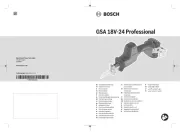
15 September 2025
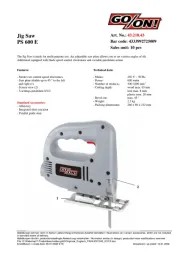
7 September 2025
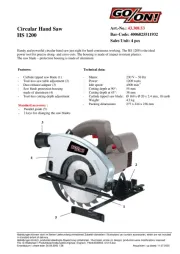
7 September 2025
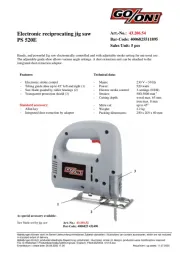
7 September 2025
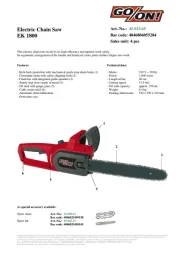
7 September 2025
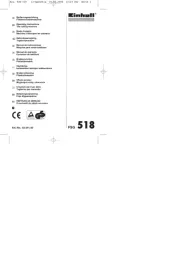
2 September 2025
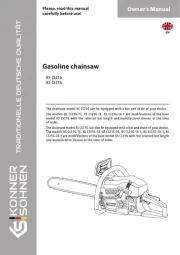
2 September 2025
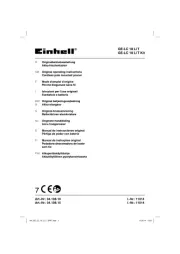
2 September 2025
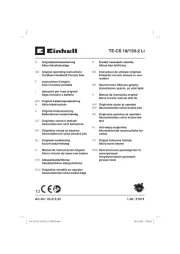
2 September 2025
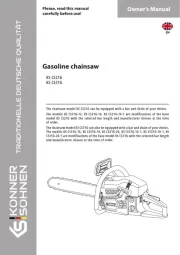
2 September 2025